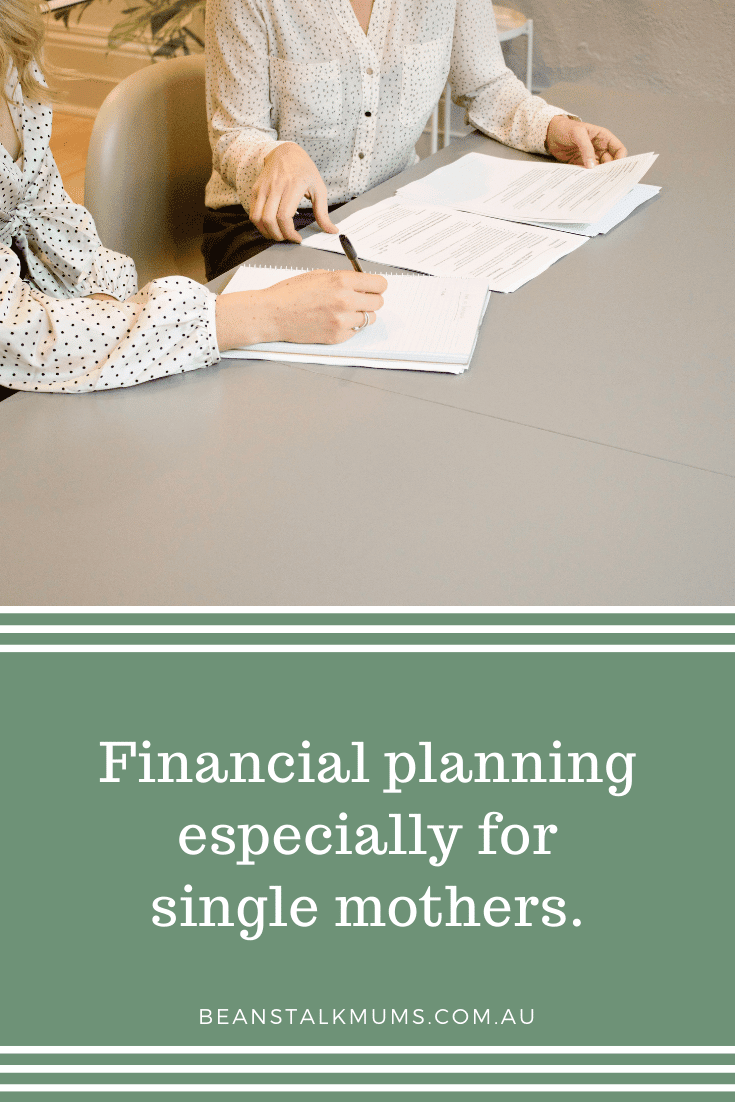
Financial planning, whether you are in a long-term relationship or single, can be a daunting exercise. However, I am here to reassure you that there is nothing to be frightened of.
When you find yourself faced with a future of going solo – getting your finances sorted and starting all over again is usually met with fear and emotion.
You are not alone. According to the Australian Bureau of Statistics (ABS):
“In 2020 there were one million single parent families, of which over 80 per cent of single parents were women.”
Going to see a financial planner is out of reach for a lot of people and it’s so hard to know where to start with planning your finances for now and in the future.
Financial planning is not a mysterious process, it is just planning your finances so they meet your goals today and in the future.
If you want to live life on your terms, it is important to plan for this. It’s time to change your money mindset.
Here are a few steps you can take to look at your own situation and get yourself on track to getting what you want from your money and becoming financially fit.
Step One: What do you want and what do you need?
You need to start with the basics and take a long hard look at your current financial situation. After all, you don’t know what you don’t know.
Financial planning is not just for retirement, it is an actual plan for life.
How you choose to spend your money is a true reflection on what you prioritise in life and your self-worth. If your priority is a family holiday or going out with friends, this shows your value on family over things.
We all know that needs and wants are two very different things but there’s no shame in having both. We all need our buckets filled.
Make a list of what in life is important to you – and maybe what you need to achieve each thing. Don’t be shy!
Congratulations! You have started your financial planning journey.
STEP TWO: Gather and analyse your financial information
It’s now time to look back over the last six months and establish where your money has been going. You can do this by looking at your bank statements (don’t forget to include your credit card account too) or some banks may offer this service.
You can also phone a friend and check in with an expert.
Your superfund will offer a financial planning service, or at least someone you can question about what you have. So will any debt providers, including your mortgage broker and afterpay or credit card providers.
Take each month at a time. You will need to go through your spending in a very detailed way and don’t leave it to guess work.
What we think we spend each month is often way more once we look more closely at it.
We live in stressful times so accept that spending too much just happens sometimes. However, don’t let online shopping stop you achieving your financial goals.
Make a list of what you own, what you owe and what you spend.
Make sure you also look up things like your super balance, insurance cover, rent, loan repayments and any other outgoings.
It is important to know what coverage your insurances are giving you. A lot of people think income protection will protect you against unemployment but most often it will only cover illness. Is the cover you currently have enough? Particularly if your situation is only recent. Make yourself aware of all things.
What are your loan repayments? Do you know what the interest rates, fees and charges are on all your debts?
How much are you paying for utilities? Could you find a better deal elsewhere?
There’s nothing wrong with not knowing any of this before now. It’s time to step out of your comfort zone and take your finances by the horns.
Your day-to-day spending is where it all starts. You want to be in a position that you can clearly see what you have and what your basic expenses are.
Once you have spent the time to go through your finances in detail, you should have a very clear idea of where and how you are spending your money.
STEP THREE: Work out your financial and life goals
A journey is pointless unless there is a destination. It’s time to write your wish list and look at what you want.
It’s time to live the life you choose and leave your fears at the door. It’s time to start living on your terms and chase what is important to you.
Money is your tool to get to where you want to go.
I like to think that budgets and diets are very similar. Being told to spend less is like being told to eat less and not fun for anyone. You need your financial journey to work for you and your lifestyle, so be realistic.
Now is the time to take a good look at your current spending and get rid of the things you don’t need. You may find it easier to track your spending through tracking apps, like The Wealth Tracker, which does the hard work for you.
Instead of making a budget and having to stick to it, it’s probably easier to know where you are spending your money and how you can cut back.
The next step to achieving your financial fitness goal is to work out what you want.
Do you want to buy a house? These are all achievable goals as long as you work out what steps you need to take to get there.
For example, if you are a first home buyer and eligible for the family home guarantee then you need 2 per cent of the property value. Or if you have already owned a home you need more like 10 per cent of any property value to cover stamp duty and costs.
There are many variables around stamp duty savings if you receive Centrelink so make part of any goal looking at what is available for you.
A home is just one example – but I know, as a single mum, it was one of my biggest priorities.
You might already own a home and want something else. No matter what it is, don’t talk yourself out of what you want. Always remember that anything is possible.
Further reading: Our pick of personal financial apps to budget your spending.
STEP FOUR: Find your experts
Don’t be afraid to ask for help. There are experts in every field who help you on your path to financial freedom.
When you look for your experts, make sure you take control. It’s your financial future not theirs so have an opinion and make sure you understand what they are saying.
If you don’t, is it because you are being sold something you don’t actually want or need?
So many women tell me about going to see a mortgage broker who has told them that as they are a single mum, they are ineligible to buy a home. This is hardly ever true. If you are working and have some money for a deposit you are at the starting line.
Don’t let the first ‘no’ you hear ruin your goals. If they think you are not in a position now, why not ask them what steps you need to take you there?
Take another look at your super and insurances. There are so many people with inadequate cover and in the wrong sort of super. This can all help you meet your financial goals.
Again, find your expert. Ask yourself if what you have got now is what you really need to cover you.
Start with your super fund and, again, if they are not speaking your language look for someone that can. They are there to help you not to make you feel confused and stupid.

The most important part of making financial decisions is that it sets you up for your life now and in the future.
Don’t play small – you don’t need to.
As a single parent your responsibility is primarily to look after yourself and your children.
Having an eye on your future keeps you in control of your present and helps you make some good decisions every day that will have a big impact on your future. Good luck!














